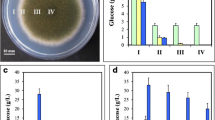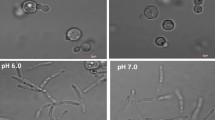Summary
Geotrichum lactis was grown in culture media with different carbon and nitrogen sources. Biotin is needed as a growth factor. During incubation in shake flasks mycelium and arthrospores are produced. Under certain conditions, such as low pH, there is a new form that we have called “yeast-like form”. This thick-walled form develops from mature arthrospores. The arthrospore and the yeastlike cells have walls with different chemical and structural composition, as observed in the electron microscope, and in their resistance to some lytic extracts.
Similar content being viewed by others
References
Agar, H. D., Douglas, H. C.: Studies of budding and cell wall structure of yeast. J. Bact. 70, 427–434 (1955).
Aguirre, M. J. R., Garcia Acha, I., Villanueva, J. R.: An enzyme from a Streptomyces sp. to prepare mould “protoplasts”. Experientia (Basel) 19, 82–83 (1963).
Bartholomew, J. W., Levin R.: The structure of Saccharomyces carlsbergensis and Saccharomyces cerevisiae as determined by ultrathin sectioning methods and electron microscopy. J. gen Microbiol. 12, 473–477 (1955).
Bartnicki-Garcia, S.: Mold-yeast dimorphism of Mucor. Bact. Rev. 27, 293–304 (1963).
Butler, E. E.: Pathogenicity and taxonomy of Geotrichum candidum. Phytopathology 50, 665–672 (1960).
Butler, E. E., Petersen, L. J.: Sexual reproduction in Geotrichum candidum. Science 169, 481–482 (1970).
Butler, E. E., Petersen, L. J.: Endomyces geotrichum, a perfect state of Geotrichum candidum. Mycologia (N.Y.) 64, 365–374 (1972).
Butler, E. E., Webster, R. K., Eckert, J. W.: Taxonomy, pathogenicity and physiological properties of the fungus causing sour rot of Citrus. Phytopathology 55, 1268 (1965).
Carbonell, L. M.: Intrayeast hyphae in Paracoccidioides brasiliensis. J. Bact. 98, 1395–1396 (1969a).
Carbonell, L. M.: Ultrastructure of dimorphic transformation in Paracoccidioides brasiliensis and brasiliensis. J. Bact. 100, 1076–1082 (1969b).
Carbonell, L. M., Rodriguez, J.: Mycelial phase of Paracoccidioides brasiliensis and Blastomyces dermatitidis: an electron microscope study. J. Bact. 96, 533–543 (1968).
Carmichael, J. W.: Geotrichum candidum. Mycologia (N.Y.) 49, 820–830 (1957).
Cole, G. T., Kendrick, W. B.: Conidium ontogeny in Hyphomycetes. The arthrospores of Oidiodendron and Geotrichum and the endoarthrospores of Sporendonema. Canad. J. Bot. 47, 1773–1780 (1969).
Feigl, F.: Spot test in organic analysis. Amsterdam-London-New York-Princeton: Elsevier Publ. Comp. 1956.
García Acha, I., Aguirre, M. J. R., Lopez-Belmonte, F., Villanueva, J. R.: Use of lipase and strepzyme for the isolation of “protoplasts” from fungal mycelium. Nature (Lond.) 209, 95–96 (1966).
Gascon, S., Ochoa, A. G., Villanueva, J. R.: Production of yeast and mold protoplasts by treatment with the strepzyme of Micromonospora AS. Canad. J. Microbiol. 11, 573–580 (1965).
Houston, M. R., Meyer, K. H., Thomal, N., Wolf, F. T.: Dimorphism in Cladosporium werneckii. Sabouraudia 7, 195–198 (1969).
Laborda, F.: Estudio sobre las paredes celulares de esporas de Fusarium culmorum. Tesis Doctoral. Facultad de Farmacia. Universidad de Santiago de Compostela (1971).
Lane, J. W., Garrison, R. G., Field, M. F.: Ultrastructural studies on the yeastlike and mycelial phase of Sporotrichum schenckii. J. Bact. 100, 1010–1019 (1969).
Lodder, J.: Die Anaskosporogen Hefen, 1ste Hälfte, Verhandel. Akad. Wettenschappen amsterdam, Adfeel. Naturkunde. 2nd. Ser. 32, 1 (1934).
Lodder, J. (Ed.): The yeast: A taxonomic study. Amsterdam: North-Holland Publ. Co. 1970
Mardon, D., Balish, E., Phillips, A. W.: Control of dimorphism in a biochemical variant of Candida albicans. J. Bact. 100, 701–707 (1969).
Park, D., Robinson, P. M.: Germination studies with Geotrichum candidum. Trans. Brit. mycol. Soc. 54, 83–92 (1970).
Uruburu, F., Monreal, J.: Producción y ultraestructura del seudomicelio de Saccharomyces fragilis. Microbiol. Español. 20, 219–232 (1967).
Van-Uden, N., do Carmo-Sousa, L.: Some physiological properties of Geotrichum candidum. Mycologia (N.Y.) 51, 595–598 (1959).
Vitols, E., North, R. J., Linnane, A. W.: Studies on the oxidative metabolism of Saccharomyces cerevisiae. I. Observations on the fine structure of the yeast cell. J. biophys. biochem. Cytol. 9, 689–699 (1961).
Author information
Authors and Affiliations
Rights and permissions
About this article
Cite this article
Duran, A., Uruburu, F. & Villanueva, J.R. Morphogenetic and nutritional studies of Geotrichum lactis cells. Archiv. Mikrobiol. 88, 245–256 (1973). https://doi.org/10.1007/BF00421849
Received:
Issue Date:
DOI: https://doi.org/10.1007/BF00421849




